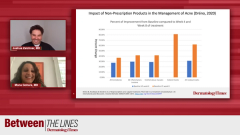
Lipid-Free Cleansers and How to Select Cleansers
Joshua Zeichner, MD, and Mona Gohara, MD, discuss different types of lipid-free cleansers and how to properly select a cleanser.
Episodes in this series

Joshua Zeichner, MD: Here is a study where the investigators looked at the properties of several of the leading brand name cleansers on the market. These are all lipid-free cleansers but what I want you guys to take from this is that not all lipid-free cleansers are created equal. This is like saying, “I'm using a serum on my face.” Well, what's in your serum? What type of serum is it? There are many different lipid-free cleansers that have different physical attributes and different benefits to the skin.
Mona Gohara, MD: Definitely. It’s important, for example, when you look at the differences amongst these, to see there's commonalities. Obviously, they all have a gentle surfactant. Many of them have glycerin, the gold standard of humectants, to bring water into the epidermal unit, trying to combat that increased transepidermal water loss that we know to be part of acne pathophysiology. Some of them also, for example, have some ceramides in them which are important because, like you brought before, another part of acne pathophysiology is a decrease in ceramides. These are not just products that are cleansing our skin and reducing the excess sebum that is part of acne. These are products that have gentle surfactants and are helping to decrease trans epidermal water loss and deposit ceramides, 2 of the main things that have been called out to be part of the barrier dysfunction that causes acne. Some have anti-inflammatory properties like niacinamide; so in a patient who has inflammatory acne, we may choose to give them a cleanser that also has an anti-inflammatory acne as opposed to a patient who has comedonal acne, who could just benefit from that ceramide, which is behind what we're seeing as one of the primary factors of creating comedones as a result of barrier dysfunction. Understanding the nuances and the ingredients can help to guide us. We may pick 1 for inflammatory acne and 1 for comedonal acne. As you said, not all cleansers are created equal.
Joshua Zeichner, MD: As dermatologists, we're writing, or recommending I should say, cleansers that are nonirritating to the skin. That's why we like these lipid-free cleansers or the syndet bars, and we know that we have tons of different options to address the patient's personal preferences and skin needs. At the most basic level, we want to give patients a cleanser that supports healthy skin cell function.
Mona Gohara, MD: Yes.
Joshua Zeichner, MD: To summarize what we talked about with respect to cleansers, these are the 3 main considerations that we have in recommending a cleanser for a patient. Number 1 is the cleansing strength. How effective is the cleanser at removing soiling vs how potentially damaging is it to the skin barrier? Especially for our acne-prone patients, those lipid-free cleansers or syndet bars are more appropriate for the skin of our acne-prone patients. Of course, we have tolerability. This is associated with how drying the products are and the pH of the cleanser, and then the irritation potential just goes in line with everything else that I was talking about. We want to balance how potentially irritating the cleanser is with how effective it is at removing soiling from the skin.
Transcript Edited for Clarity
Newsletter
Like what you’re reading? Subscribe to Dermatology Times for weekly updates on therapies, innovations, and real-world practice tips.



















